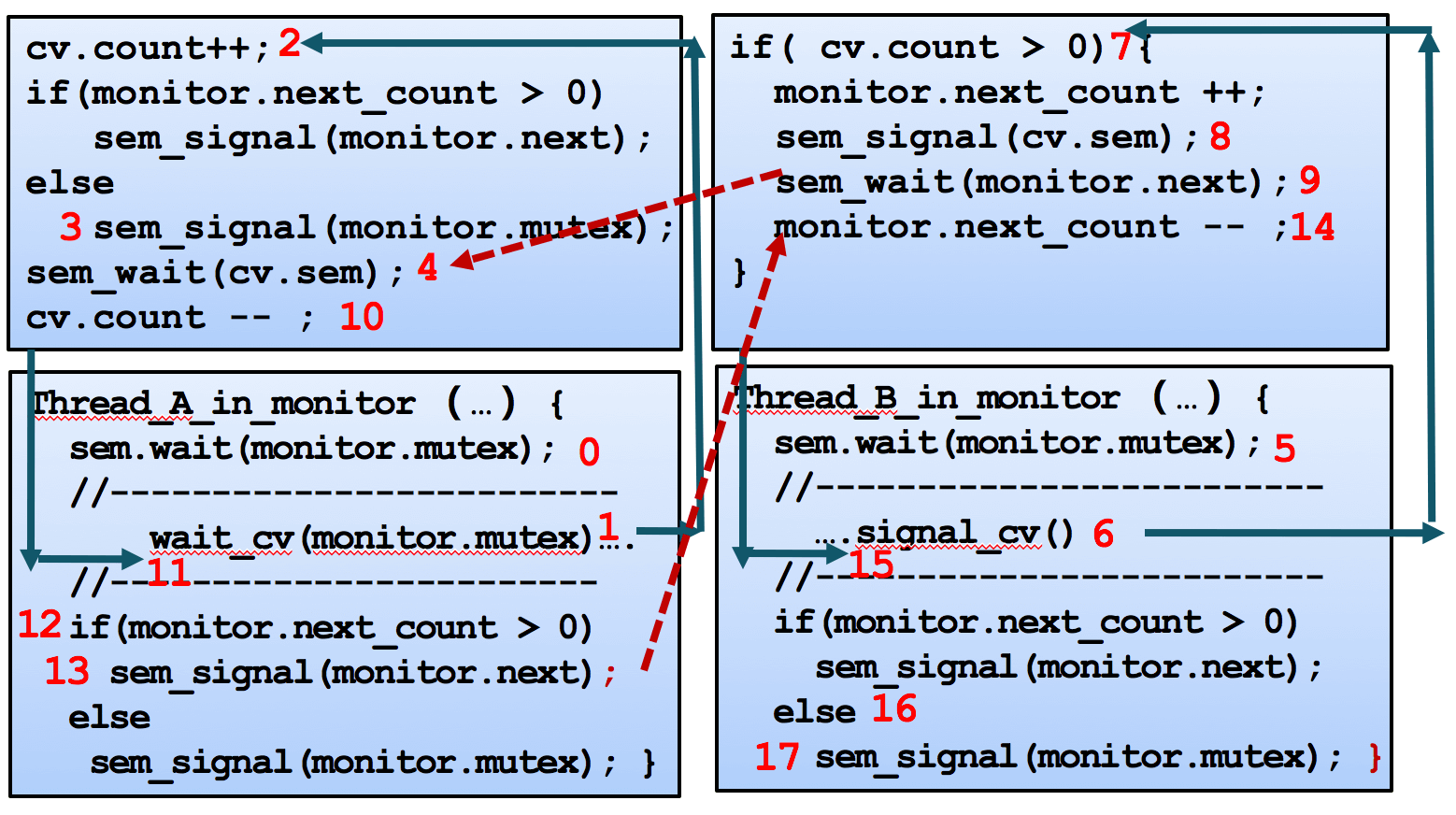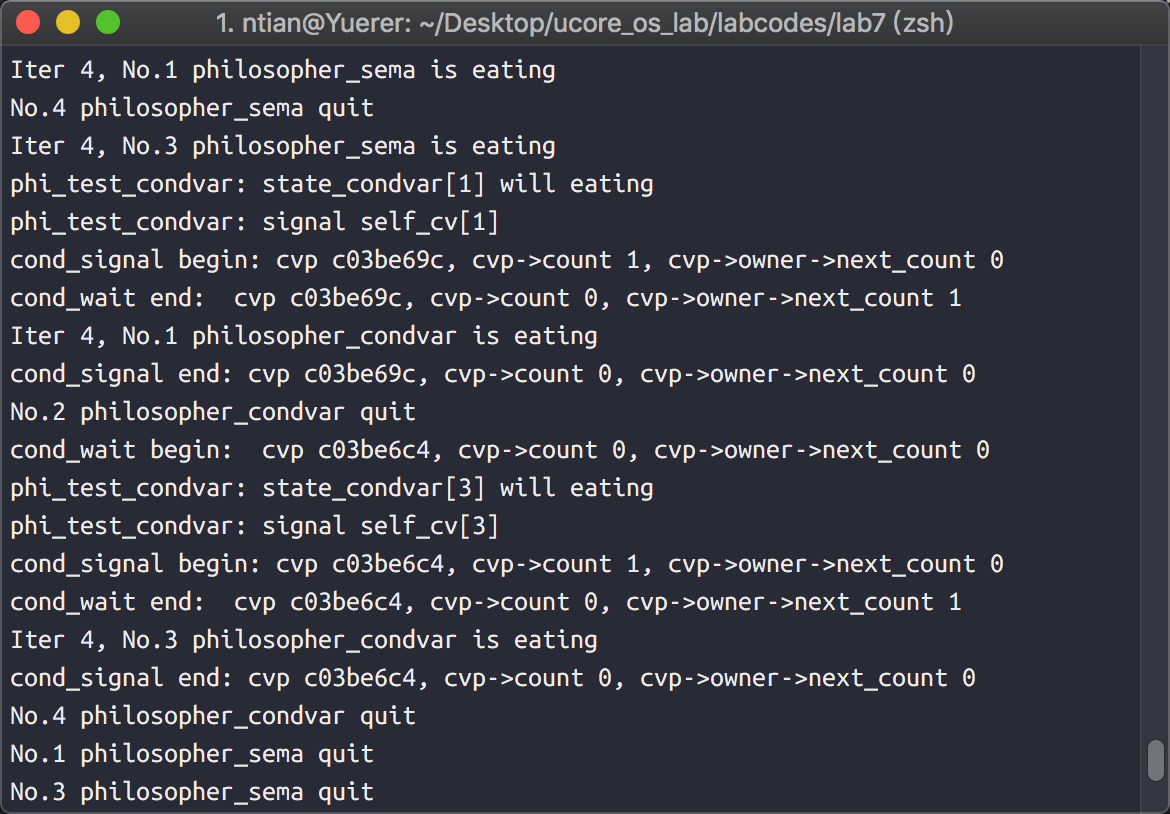练习0:填写已有实验
请把你做的实验代码填入本实验中代码中有“LAB1”/“LAB2”/“LAB3”/“LAB4”/“LAB5”/“LAB6”的注释相应部分。并确保编译通过。注意:为了能够正确执行lab7的测试应用程序,可能需对已完成的实验1/2/3/4/5/6的代码进行进一步改进。
1
2
3
4
5
6
7
8
9
10
| 这次又是要修改 trap.c
vmm.c trap.c default_pmm.c pmm.c proc.c swap_fifo.c
trap.c:
static void trap_dispatch(struct trapframe *tf) {
++ticks;
run_timer_list();
}
|
练习1: 理解内核级信号量的实现和基于内核级信号量的哲学家就餐问题
请在实验报告中给出内核级信号量的设计描述,并说其大致执行流流程。
1
2
3
4
5
6
7
8
9
10
11
12
13
14
15
16
17
18
19
20
21
22
23
24
25
26
27
28
29
30
31
32
33
34
35
36
37
38
39
40
41
42
43
44
45
46
47
48
49
50
51
52
53
54
55
56
57
58
59
60
61
62
63
64
65
66
67
68
69
70
71
|
typedef struct {
int value;
wait_queue_t wait_queue;
} semaphore_t;
typedef struct {
struct proc_struct *proc;
uint32_t wakeup_flags;
wait_queue_t *wait_queue;
list_entry_t wait_link;
} wait_t;
void sem_init(semaphore_t *sem, int value) {
sem->value = value;
wait_queue_init(&(sem->wait_queue));
}
static __noinline uint32_t __down(semaphore_t *sem, uint32_t wait_state) {
bool intr_flag;
local_intr_save(intr_flag);
if (sem->value > 0) {
sem->value --;
local_intr_restore(intr_flag);
return 0;
}
wait_t __wait, *wait = &__wait;
wait_current_set(&(sem->wait_queue), wait, wait_state);
local_intr_restore(intr_flag);
schedule();
local_intr_save(intr_flag);
wait_current_del(&(sem->wait_queue), wait);
local_intr_restore(intr_flag);
if (wait->wakeup_flags != wait_state) {
return wait->wakeup_flags;
}
return 0;
}
static __noinline void __up(semaphore_t *sem, uint32_t wait_state) {
bool intr_flag;
local_intr_save(intr_flag);
{
wait_t *wait;
if ((wait = wait_queue_first(&(sem->wait_queue))) == NULL) {
sem->value ++;
}
else {
assert(wait->proc->wait_state == wait_state);
wakeup_wait(&(sem->wait_queue), wait, wait_state, 1);
}
}
local_intr_restore(intr_flag);
}
|
请在实验报告中给出给用户态进程/线程提供信号量机制的设计方案,并比较说明给内核级提供信号量机制的异同。
1
2
3
| 可以将内核级信号量 包装成系统调用 供用户进程使用 但不能直接使用信号量结构体的指针作为参数
不能持有或访问内核的指针 可以在每个进程的PCB里维护一个信号量指针数组 供用户态进程及其进程下的多线程使用
不同的地方在于 需要通过系统调用进入 内核态 进行操作
|
练习2: 完成内核级条件变量和基于内核级条件变量的哲学家就餐问题
首先掌握管程机制,然后基于信号量实现完成条件变量实现,然后用管程机制实现哲学家就餐问题的解决方案(基于条件变量)。
请在实验报告中给出内核级条件变量的设计描述,并说其大致执行流流程。
首先可以确定 这里实现的是 Hoare管程 因为 等待条件变量的进程的优先级更高
1
2
3
4
5
6
7
8
9
10
11
12
13
14
15
16
17
18
19
20
21
22
23
24
25
26
27
28
29
30
31
32
33
34
35
36
37
38
39
40
41
42
43
44
45
46
47
48
49
50
51
52
53
54
55
56
57
58
59
60
61
62
63
64
65
66
67
68
69
70
71
72
73
|
typedef struct monitor{
semaphore_t mutex;
semaphore_t next;
int next_count;
condvar_t *cv;
} monitor_t;
typedef struct condvar{
semaphore_t sem;
int count;
monitor_t * owner;
} condvar_t;
void monitor_init (monitor_t * mtp, size_t num_cv) {
int i;
assert(num_cv>0);
mtp->next_count = 0;
mtp->cv = NULL;
sem_init(&(mtp->mutex), 1);
sem_init(&(mtp->next), 0);
mtp->cv =(condvar_t *) kmalloc(sizeof(condvar_t)*num_cv);
assert(mtp->cv!=NULL);
for(i=0; i<num_cv; i++){
mtp->cv[i].count=0;
sem_init(&(mtp->cv[i].sem),0);
mtp->cv[i].owner=mtp;
}
}
void cond_wait (condvar_t *cvp) {
cprintf("cond_wait begin: cvp %x, cvp->count %d, cvp->owner->next_count %d\n", cvp, cvp->count, cvp->owner->next_count);
cvp->count++;
if (cvp->owner->next_count > 0) {
up(&(cvp->owner->next));
} else {
up(&(cvp->owner->mutex));
}
down(&(cvp->sem));
cvp->count--;
cprintf("cond_wait end: cvp %x, cvp->count %d, cvp->owner->next_count %d\n", cvp, cvp->count, cvp->owner->next_count);
}
void cond_signal (condvar_t *cvp) {
cprintf("cond_signal begin: cvp %x, cvp->count %d, cvp->owner->next_count %d\n", cvp, cvp->count, cvp->owner->next_count);
if (cvp->count > 0) {
up(&(cvp->sem));
cvp->owner->next_count++;
down(&(cvp->owner->next));
cvp->owner->next_count--;
}
cprintf("cond_signal end: cvp %x, cvp->count %d, cvp->owner->next_count %d\n", cvp, cvp->count, cvp->owner->next_count);
}
|
![lab7_monitor]()
1
2
3
4
5
6
7
8
9
10
11
12
13
14
15
16
17
18
19
20
21
22
23
24
25
26
27
28
29
30
31
32
33
34
35
36
37
| check_sync.c:
void phi_test_condvar (i) {
if(state_condvar[i]==HUNGRY&&state_condvar[LEFT]!=EATING
&&state_condvar[RIGHT]!=EATING) {
cprintf("phi_test_condvar: state_condvar[%d] will eating\n",i);
state_condvar[i] = EATING ;
cprintf("phi_test_condvar: signal self_cv[%d] \n",i);
cond_signal(&mtp->cv[i]) ;
}
}
void phi_take_forks_condvar(int i) {
down(&(mtp->mutex));
state_condvar[i] = HUNGRY;
phi_test_condvar(i);
while (state_condvar[i] != EATING) {
cond_wait(&mtp->cv[i]);
}
if(mtp->next_count>0)
up(&(mtp->next));
else
up(&(mtp->mutex));
}
void phi_put_forks_condvar(int i) {
down(&(mtp->mutex));
state_condvar[i] = THINKING;
phi_test_condvar(LEFT);
phi_test_condvar(RIGHT);
if(mtp->next_count>0)
up(&(mtp->next));
else
up(&(mtp->mutex));
}
|
1
2
3
4
5
6
| 哲学家->试试拿刀叉->能拿->signal 唤醒被wait阻塞的进程->阻塞自己
| | A
| V |
->不能拿->wait阻塞自己 |
|
哲学家->放刀叉->让左右两边试试拿刀叉->有哲学家睡在signal 唤醒他
|
请在实验报告中给出给用户态进程/线程提供条件变量机制的设计方案,并比较说明给内核级提供条件变量机制的异同。
请在实验报告中回答:能否不用基于信号量机制来完成条件变量?如果不能,请给出理由,如果能,请给出设计说明和具体实现。
实验完成结果
![lab7_finish]()

